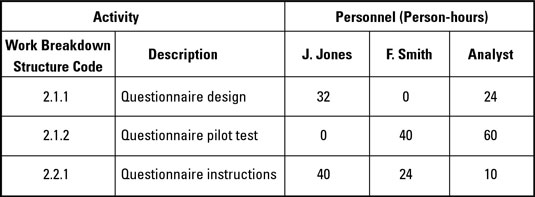As a project manager, you must determine how many people you'll need to complete the project on time. Planning personnel needs begins with identifying whom you need and how much effort they have to invest. You can use a Human Resources Matrix to display this information.
Work effort is related to, but different from, duration. According to the matrix, J. Jones works on this activity for 32 person-hours, and an unnamed analyst works on it for 24 person-hours:

Work effort is related to, but different from, duration. According to the matrix, J. Jones works on this activity for 32 person-hours, and an unnamed analyst works on it for 24 person-hours.
Knowing the work effort required to complete a work package alone, however, doesn’t tell you the duration of the work package. For example, if both people assigned to the questionnaire design work package can do their work on it at the same time, if they’re both assigned 100 percent to the project, and if no other aspects of the task take additional time, the activity may be finished in four days. However, if either person is available for less than 100 percent of the time, if one or both people must work overtime, or if one person has to finish her work before the other can start, the duration won’t be four days.
Begin to create your Human Resources Matrix by specifying in the top row the different types of personnel you need for your project. You can use three types of information to identify the people you need to have on your project team:
Skills and knowledge: The specific skills and knowledge that the person who’ll do the work must have
Position name or title: The job title or the name of the position of the person who’ll do the work
Name: The name of the person who’ll do the work
Eventually, you want to specify all three pieces of information for each project team member. Early in your planning, try to specify needed skills and knowledge, such as must be able to develop work process flow charts or must be able to use Microsoft PowerPoint. If you can identify the exact skills and knowledge that a person must have for a particular task, you increase the chances that the proper person will be assigned.
Often, you want to identify people you want on your project by name. The reason is simple: If you’ve worked with someone before and he’s done a good job, you want to work with him again. Although it’s great for that person’s ego, this method, unfortunately, often reduces the chances that you’ll get an appropriately qualified person to work on your project. People who develop reputations for excellence often get more requests to participate on projects than they can handle. When you don’t specify the skills and knowledge needed to perform the particular work on your project, the manager — who has to find a substitute for that overextended person — doesn’t know what skills and knowledge that the alternate needs to have.
On occasion, you may use a position description or title (such as operations specialist) to identify a needed resource. In doing so, you assume anyone with that title has the necessary skills and knowledge. Unfortunately, titles are often vague, and position descriptions are frequently out of date. Therefore, using titles or position descriptions are risky ways to get the right person for the job.

